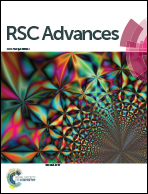A pH tuning single fluorescent probe based on naphthalene for dual-analytes (Mg2+ and Al3+) and its application in cell imaging†
Abstract
In this study, a naphthalene Schiff-base P which serves as a dual-analyte probe for the quantitative detection of Al3+ and Mg2+ has been designed. The proposed probe showed an ‘‘off–on’’ fluorescent response toward Al3+ in ethanol–water solution (1 : 9, v/v, pH 6.3, 20 mM HEPES) over other metal ions and anions, while the detection by the probe could be switched to Mg2+ by regulating the pH from 6.3 to 9.4. The sensing mechanisms of P to Al3+/Mg2+ are attributed to inhibition of the photo-induced electron transfer (PET) process by the formation of 1 : 1 ligand–metal complexes. More importantly, the probe was applied successfully in living cells for the fluorescent cell-imaging of Al3+ and Mg2+.



 Please wait while we load your content...
Please wait while we load your content...